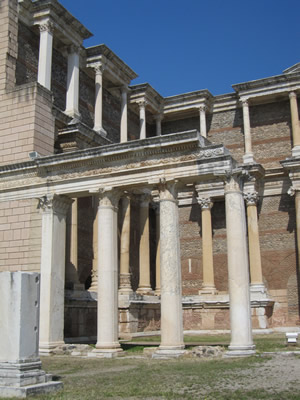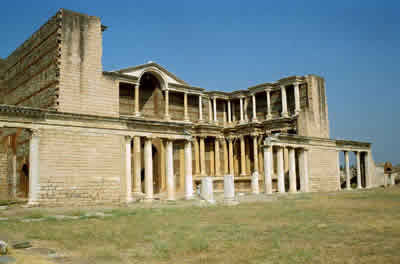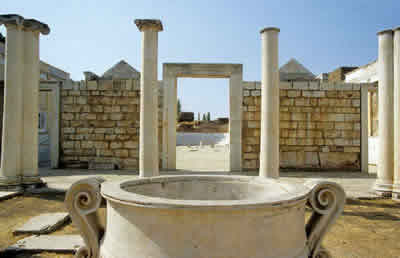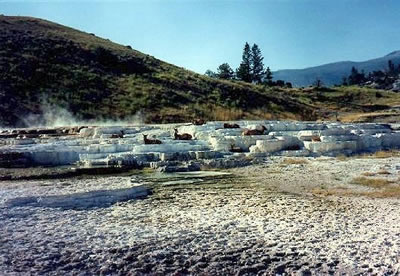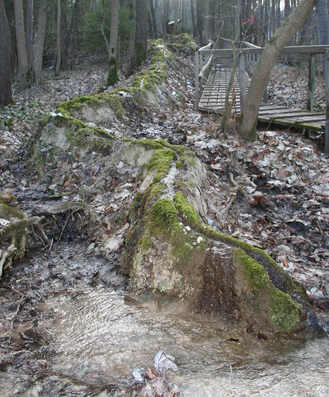
Classic Turkey trip, 2012
SARDIS - PAMUKKALE
HOME :
turkey trip Istanbul I Istanbul II Istanbul III Istanbul IV Bursa Troy Pergamum Sardes - Pamukkale Aphrodisia Ephesus Priene Didyma MiletCapitels
Sardes - Pamukkale
| On the eight day of our trip we first visited Sardes - definitely a "white rocks" aka ruins place and then Pamukkale a natural wonder and UNESCO World Heritage Site | ||
| Sardes | ||
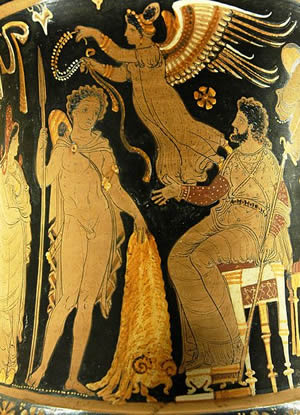 |
Sardis history reaches far into archaic times. According to Herodot the city was founded by the Heraklides who traced their family back to Herakles. Wheter there is any truth to the tale or not, Sardis was an important and very rich city in the Lydian empire, until the last Lydian king , Kroisos (555–541 BCE) was killed by the victorious Persians. Yes, THE Croeusus. Whether he was as rich as rumoured is not known, but the little river Paktolos contained gold sands. In ancient times sheep fleece was used to trap the gold, that may have led to the myth of the Golden Fleece. After the death of Kroisos the town's fortunes varied through a series of rulers - Persia; Greece; Rome; Byzantium; until finally in the 14th century it became part of the developing Ottoman empire. Archaic Sardes was largely destroyed through, take your pick - earthquakes and/or wars, not to ignore the uprising of the Greeks against the Persians (499 BCE). Reading the history of Sardes - who with and/or against whom - is enough to give one a headache. It also makes it VERY clear that the good old times consisted largely of bloody fights between sometimes large, sometimes small countries or more likely city states. Among the more famous warlords or kings that played a role in the history of Sardis, Alexander the Great should not be ignored; with his victory at the river Granikos, Sardes became part of the Hellenistic empire. | |
In Rom soldiers were recruited from many parts of the empire; the had to serve twenty-five years. Then, assuming they were still alive, the received a pension, permission to marry and were settled on land near their duty station. As a result, todays DNA research has found some interesting diversity among populations all over Europe and the Middle East. In Sardis this practice led to the settlement of Jewish veterans at some time BCE, which shortly after the death of Christ lead to the development of a Christian community. Consequently, Sardes figures in writings of the New Testament. It is known that the apostle Paul visited here and wrote letters to the local community. He also had nasty things to say about the temple of Artemis! Eventually as a result of natural and man made causes, Archaic Sardis on the hill largely disappeared, only the Roman/Byzantine vestiges in the town below were to some extent visible. The Excavation of Sardis began just before WWI, led by US archeologists who uncovered the ruins of the giant temple of Artemis . The war put an end to this first phase. It was resumed at a later time and to some extent is still ongoing today under the leadership of Harvard. Among the important finds are the Gymnasion; the Byzantine era shops; the giant Synagoge; and the theater |
||||
|
Gymnasion |
 |
||
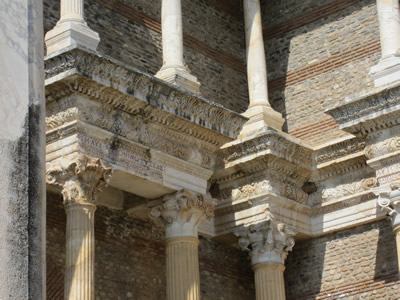 |
 |
In roman times the very large thermal baths and gymnasium complex was in use for about 450 – 500 years; eventually Rome became Byzanthium, Christianity tok over, bathing became sinful and the baths were closed and "repurposed" |
||
| Latrine in the Gymnasion | ||||
 |
Synagoge - some reconstruction - the synagoge had a length of 300 feet, making it one of the most impressive synagoges outside the Jewish homeland. The synagoge is located in what used to changing rooms or resting rooms of the gymnasion in the middle of the 2nd century CE. The complex was destroyed in 616 AD by the Sassanian-Persians | |||
 |
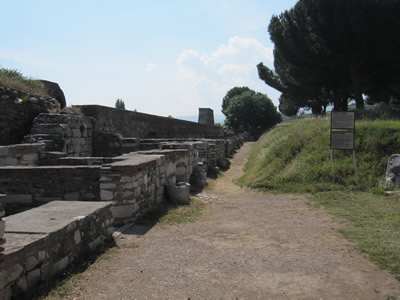 |
 |
||
| Gymnasion facade detail | Another example of repurposing: After the gymnasion had been abandoned in Byzantine times, shops and taverns were built on the walls along the outside of the gymnasion The pictures show the shops which have been partially reconstructed | |||
|
|
|||
| The Temple of Artemis and the Theater | ||||
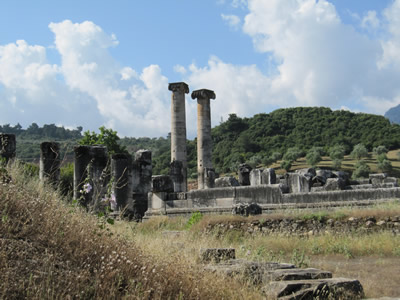 |
On the top of the hill, above the modern city, are the ruins of the Sardis of Antiquity with, among others, the ruins of the temple of Artemis and the theater. Pictures of the temple ruins are to the left and below. The Artemis temple had been intended to be a gigantic complex, but was never completed. That is hardly surprising, considering the almost constant warfare and/or natural catstrophes that regularly devastated the area. Perhaps marble is not the best building material in earthquake country. Another reason for the abandonment of the city on the hill (was it by any chance "shining"?) was the fact that its harbor also disappeared under the encroaching sands brought by the Meander river. |
|||
 |
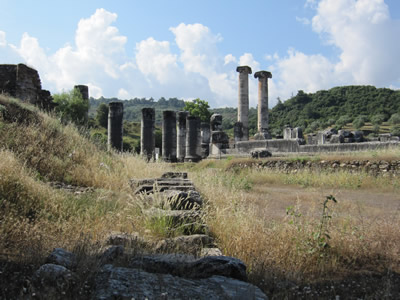 |
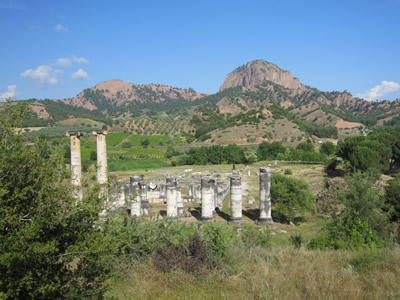 |
||
 |
On the left the extremely steep Greek Theater - like all early theaters it is built directly into the hillside without external supports - the technology to do so had not yet been invented, one way to determine that this was a Greek not a Roman theater. | 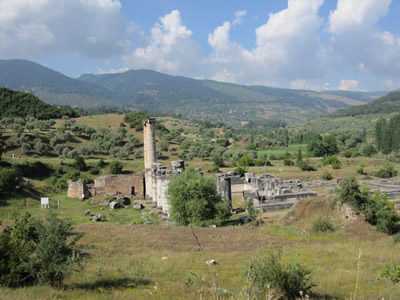 |
||
| Pamukkale | How it looked then and we hope it will look like it again soon | ||||
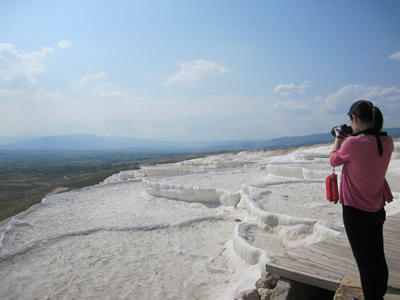 |
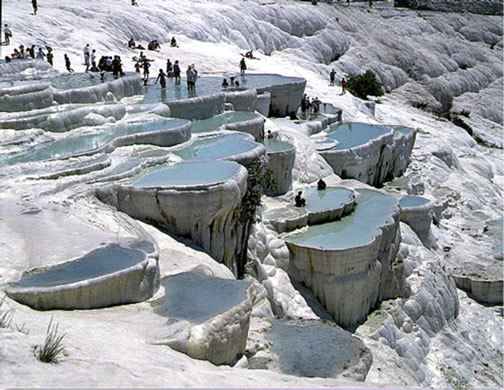 |
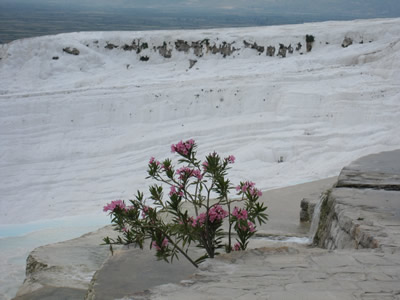 |
|||
filled with algae and many of the terraces and pools were severly damaged. UNESCO threatened to remove the World Heritage label, unless drastic changes were made. So, the hotels were demolished, the street flooded, no private cars are allowed to drive to the actual site, People are still allowed to walk on the old street, but there are guards who quickly whistle back anyone who attempts to step into the pools. When the highly calcium saturated water streams over the terraces, it deposits travertine minerals which eventually harden and form the pools and terraces one can see in the picture in the middle above. To encourage the restoration of the site, the terraces were divided into twenty sections and are flooded and let dry according to a carefully calibrated system. Whenever the water is turned off, the calcium has a chance to settle and harden and reform the damaged edges of the pools. Significant regeneration has already occurred, but it is expected that it will take another twenty years before the site is fully restored. (We heard another explanation for the water rationing: allegedly there is a serious decline in the ground water level, as a result of increased agricultural activities it has sunk from 50 meter down to only 10 meter. Unfortunately, I have no independent information as to which story is correct. perhaps there is some truth to both.) Along the terraces footpaths have been constructed so one can walk and observe the different parts of the site (and take pictures like the young lady above). There are sanctioned swimming or rather wallowing pools where tourists can cavort in the hot spring water, something that appears to be particularly popular with Russian. |
|||||
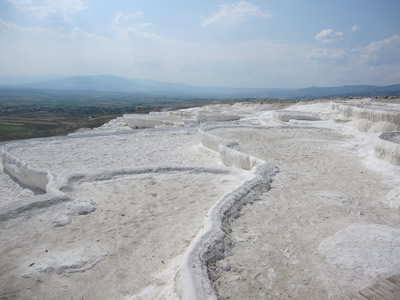 |
 |
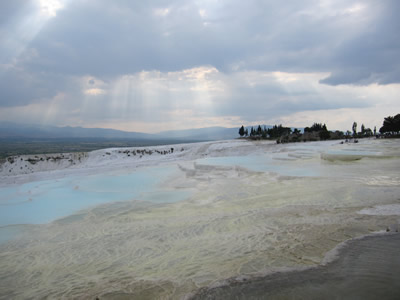 |
|||
The pictures above show a dry terrace, in the middle picture one can see the travertine formation and on the left is a section that is being flooded. The water has a naturally blue color due to the minerals suspended in it. The travertine terraces at Pammukale are very rare, among only three or four in the world. As I was working on this page I recalled that Birgit and I had visited recently another site that boasts natural hot springs |
|||||
|
Mammoth Hot Springs travertine terraces in Yellowstone National Park, USA |
Steinerne Rinne near Heidenheim , Germany |
travertine terraces in Pammukale, Turkey |
|||
with similar travertine terraces as Pammukale: Yellowstone National Park in the US. Above left is a picture of the travertine terraces there. However, whether it is because there is no hill for the water to run down or for some other reason, the terraces seem much smaller, than then ones in Pammukale. Then I remembered something else: the "Steinerne Rinne" ("the stone channel") near my family's ancestral village of Heidenheim. Here the calcium rich water of a little brook that is only 128 m long (less than 400 feet) has created a dam or channel that is at this time 160 cm (about five feet) high - "an outdoor stalagmite" Nick says. return to top |
|||||
